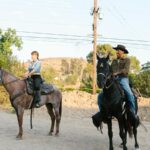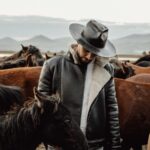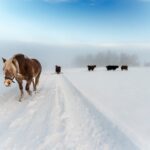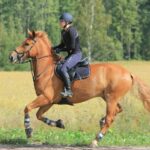In the vast expanses of ranching country, where the horizon stretches endlessly and cattle dot the landscape like mobile specks, one animal has remained an indispensable partner to ranchers for centuries: the horse. Despite technological advances and the introduction of ATVs, trucks, and helicopters into modern ranching, horses continue to play a crucial role in large-scale cattle operations across the world. Their unique combination of mobility, intelligence, and instinctive understanding of livestock behavior makes them irreplaceable assets in the challenging environment of extensive ranching. From the sprawling operations of the American West to the vast stations of Australia and the campos of South America, horses remain the backbone of efficient livestock management, embodying a working partnership between humans and animals that has stood the test of time.
Historical Evolution of Horses in Ranching

The relationship between horses and cattle management dates back to the Spanish conquistadors who introduced both species to the Americas in the 16th century. As cattle ranching expanded across North America, the role of the horse became increasingly specialized, with vaqueros in Mexico and later cowboys in the United States developing sophisticated horsemanship techniques specifically designed for handling cattle. These early ranching operations relied entirely on horses for every aspect of the work, from gathering scattered cattle across vast territories to driving herds to market across hundreds of miles. The legendary cattle drives of the 19th century, moving thousands of longhorns from Texas to railheads in Kansas, would have been impossible without the endurance and skill of cow horses and their riders. This historical foundation established practices and traditions that continue to influence modern ranching, even as operations have grown in scale and complexity.
The Modern Ranch Horse: Specialized Characteristics

Today’s ranch horses represent generations of selective breeding for the specific attributes required in working cattle. Quarter Horses dominate American ranching operations due to their compact build, explosive acceleration, and natural “cow sense” that helps them anticipate and respond to cattle movements. Australian Stock Horses serve a similar function in the Outback, while criollo horses are prized in South American operations for their hardiness and adaptability to demanding terrain. Modern ranch horses must possess an athletic build that balances speed with endurance, allowing them to work effectively through long days that might involve covering 20-30 miles of territory. Beyond physical characteristics, the ideal ranch horse displays intelligence, level-headedness under pressure, and the ability to work independently when necessary. Perhaps most importantly, these horses develop an almost intuitive understanding of cattle behavior, making them partners rather than mere transportation in the complex work of livestock management.
Gathering Operations: The Horse’s Unmatched Mobility

When it comes to gathering dispersed cattle from remote pastures, horses offer advantages that mechanical alternatives simply cannot match. Unlike ATVs or trucks, horses can navigate through dense brush, cross rocky terrain, ford streams, and climb steep hillsides without damaging the landscape or disturbing wildlife. On large ranches where pastures may span thousands of acres, mounted cowboys can spread out across the land, covering territory efficiently while maintaining communication through traditional whistles and hand signals. Horses’ natural predatory instincts, properly channeled through training, make them effective at locating cattle hidden in thick vegetation, while their speed and agility allow riders to outmaneuver and turn animals attempting to escape. During gathering operations, horses work in near silence, creating less stress for cattle than the noise of motors, which results in less weight loss and injury to valuable livestock.
Cutting and Sorting: Precision Livestock Handling

The art of cutting—separating specific animals from the herd—remains one of the most specialized skills in ranching, where the partnership between horse and rider reaches its highest expression. Well-trained cutting horses can isolate a single cow from the herd and hold it separate through a series of quick, responsive movements that mirror and counter the cow’s attempts to rejoin its companions. This precision work becomes essential during operations like selecting animals for medical treatment, separating calves for weaning, or sorting cattle by weight, age, or other characteristics. During sorting operations, horses can make rapid directional changes with a responsiveness that mechanical vehicles cannot replicate, allowing for quick decision-making as hundreds of animals move through processing facilities. The low-stress handling enabled by skilled horses and riders has measurable economic benefits, reducing shrinkage (weight loss due to stress) and potential injuries to valuable livestock.
Cattle Drives and Pasture Rotations

Moving cattle between pastures or to processing facilities represents one of the most visible aspects of ranch work where horses demonstrate their value. Horses position themselves strategically around a herd, with experienced animals understanding their role in maintaining formation and keeping cattle moving in the desired direction. On large ranches practicing rotational grazing across extensive territories, horses can cover the necessary distances without requiring fuel or mechanical maintenance, making them cost-effective for regular movements. The height advantage offered to mounted riders provides superior visibility across the herd, allowing them to spot potential problems before they develop into serious issues. Perhaps most importantly, cattle respond to horses differently than to mechanical vehicles, recognizing them as natural elements in their environment and moving more willingly when guided by mounted riders who understand proper pressure and release techniques.
Rope Work and Doctoring Cattle

When individual animals require treatment in remote locations, the combination of a skilled rider and well-trained horse makes field doctoring possible without the stress and expense of bringing the entire herd to handling facilities. Ranch horses used for roping must possess both the speed to pursue fast-moving cattle and the strength and stability to hold roped animals securely while treatments are administered. These horses learn to position themselves at precise angles during roping attempts, giving their riders optimal opportunities for successful catches. After an animal is roped, horses automatically apply and maintain tension on the rope, backing slowly to keep the cow under control while the rider dismounts to administer medication or treatment. This field doctoring capability saves countless hours and significantly reduces stress on animals that would otherwise need to be driven to distant processing facilities for routine treatments.
Economic Considerations: Horses vs. Mechanical Alternatives

The economics of horse use in modern ranching involves a complex calculation of benefits against costs that varies based on operation size, terrain, and management philosophy. While the initial investment in a trained ranch horse (typically $5,000-$15,000 for a well-started animal) represents a significant expense, horses offer operational longevity often exceeding 15 years of productive work. Unlike mechanical vehicles, horses reproduce themselves, with many ranches maintaining breeding programs that supply their own working stock while potentially generating additional income through sales of quality animals. The daily operating costs of horses compare favorably to mechanical alternatives when considering fuel, repairs, and depreciation, particularly on operations where grazing land for horse maintenance is already available. Many large ranches find the optimal approach combines horses for certain tasks with mechanical support for others, creating systems that maximize the advantages of each while minimizing their respective limitations.
Training and Development of Ranch Horses

The making of an effective ranch horse involves a methodical training process typically spanning several years, representing a significant investment of time and expertise. Most ranch horses begin their education between two and three years of age, learning basic commands and developing comfort with the equipment and environments they’ll encounter in their working lives. Progressive training then introduces specific cattle-working skills, from quietly trailing behind cattle to the more challenging tasks of cutting and roping. Large ranching operations often employ specialized horse trainers who develop young stock, or they may send promising animals to professional trainers for periods of focused education. The most successful ranches implement mentorship systems where experienced riders work with young horses alongside seasoned mounts, allowing the inexperienced horses to learn from both human direction and the example of their more knowledgeable equine partners.
Care and Management of the Ranch Remuda

Maintaining a healthy, effective horse remuda (the collection of working horses) requires systematic management tailored to the demands of ranch work. Large operations typically maintain between four and eight horses per full-time rider, allowing for rotation that prevents overuse and accounts for varying terrain and work requirements. Nutrition programs for working ranch horses must balance energy requirements during intense work periods with maintenance needs during slower seasons, often combining grazing with strategic supplementation. Health management involves regular veterinary care, including vaccinations, dental work, and prompt attention to injuries that could compromise performance or welfare. Hoof care becomes particularly critical for ranch horses working across varied and often challenging terrain, with regular trimming or shoeing schedules maintained despite logistical challenges on remote operations.
The Specialized Breeding of Ranch Horses

Many large ranching operations maintain their own breeding programs, carefully selecting for traits that enhance working ability in their specific environments. These breeding efforts focus on practical traits rather than show-ring standards, prioritizing attributes like soundness, endurance, intelligence, and natural livestock handling ability. Mares selected for breeding programs typically demonstrate exceptional working ability themselves, proving their value in real-world ranch conditions before joining the broodmare band. Stallion selection often reaches beyond the individual ranch, with operations seeking genetics that complement their mare lines while addressing any weaknesses in their existing stock. The long-term nature of horse breeding means that ranch managers must think generationally, making breeding decisions today that will affect their working remuda a decade into the future.
Environmental Benefits of Horse Use

In an era of increasing environmental consciousness, horses offer ecological advantages that align with sustainable ranching practices. The minimal ground pressure exerted by horses causes significantly less soil compaction and erosion than motorized vehicles, particularly in sensitive riparian areas or during wet conditions. Horses produce biodegradable waste that contributes to nutrient cycling within the grazing ecosystem rather than introducing pollutants. The quiet operation of horses reduces noise pollution that can disturb wildlife and disrupt natural behaviors across the landscape. On ranches pursuing carbon-neutral or regenerative agriculture goals, the reduced fossil fuel consumption associated with horse use represents a meaningful contribution to sustainability objectives.
Cultural and Historical Legacy in Modern Ranching

Beyond their practical utility, horses connect modern ranching operations to cultural traditions and historical practices that form an important part of ranching identity. Many of today’s large ranches maintain traditions of horsemanship that have been passed down through multiple generations, preserving skills and knowledge that might otherwise disappear. These cultural elements influence everything from the equipment used (much of which remains surprisingly similar to that employed a century ago) to the language and customs that define ranch life. For many ranching families and communities, horses represent not just working tools but living links to a heritage that provides meaning and continuity in a rapidly changing world. This cultural dimension adds value beyond economic calculations, contributing to the resilience and identity of ranching communities facing modern challenges.
Future Prospects: Horses in Tomorrow’s Ranching Operations

As ranching continues to evolve in response to economic pressures, technological innovations, and changing consumer expectations, the role of horses appears secure but will likely continue adapting. Advanced breeding technologies like artificial insemination and embryo transfer are allowing ranches to accelerate genetic improvement in their horse herds, developing animals even better suited to specific working environments. Some innovative operations are exploring complementary relationships between traditional horse work and modern technology, such as using GPS tracking on horses during gathering operations or incorporating drone reconnaissance with horseback follow-up. Climate change considerations may actually enhance the value of horses in regions facing increasing fuel costs or more frequent extreme weather events that limit mechanical access. While the percentage of work performed by horses versus machines may fluctuate with economic conditions and technological developments, the fundamental partnership between ranchers and horses shows every sign of continuing into the foreseeable future.
Conclusion

The enduring presence of horses in large-scale ranching operations represents more than mere tradition or sentimentality—it reflects their continued practical utility in an industry that demands efficiency and effectiveness. Modern ranchers maintain horses because they work, providing capabilities that mechanical alternatives cannot fully replicate despite technological advances. From their unmatched mobility across challenging landscapes to their innate understanding of livestock behavior, horses bring specialized skills to ranching that have economic, environmental, and cultural value. As ranching continues adapting to changing conditions in the 21st century, horses will undoubtedly evolve in their specific roles, but the fundamental partnership between ranchers and their equine partners appears poised to continue, representing one of agriculture’s most enduring and productive human-animal collaborations.







